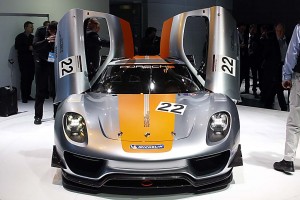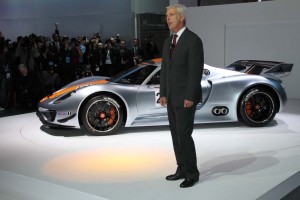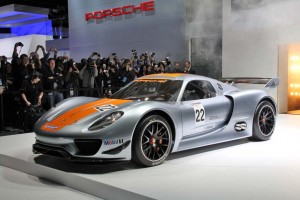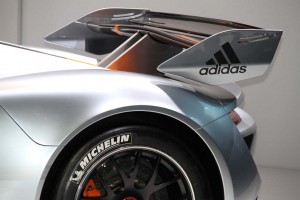The mystery is over. While most makers have been providing clues – sometimes even complete dossiers – on the products they planned to launch at this year’s North American International Auto Show, Porsche kept everyone guessing until the coffee was boiling at their early morning press conference.
And the big news: the 918 RSR, a track-ready version of last year’s striking 918 supercar, which promises to continue a long tradition of bringing cutting-edge technology to the track.
 “This car will serve to explore the use of alternative power in extreme conditions,” declared Porsche CEO Matthias Muller, to a crowd packed into Porsche’s corner of Cobo Hall.
“This car will serve to explore the use of alternative power in extreme conditions,” declared Porsche CEO Matthias Muller, to a crowd packed into Porsche’s corner of Cobo Hall.
The debut of the 918 RSR was noteworthy for several reasons, including the automaker’s return after a several-year absence from the Detroit Auto Show, where more than 30 new vehicles and concepts will have their public introduction. But few will pack the power to the new Porsche race car.

The 918 RSR has a "Post-Modern, form-follows-function design," suggests Porsche CEO Matthias Muller.
The 918 RSR picks up on some of the technology first seen last year on both the 918 concept and the Porsche GT3R race car. The primary source of power is a 563 horsepower V8. But at the touch of a button, the driver can access the energy stored in a flywheel system mounted in what would otherwise be the passenger seat.
That flywheel hybrid system captures energy produced by the 918 RSR’s regenerative brakes. But instead of storing it in a battery – which usually limits the speed with which the power can be tapped – energy is used to spin up the flywheel. When it’s needed, that kinetic energy is turned back into electricity, instantly punching out an additional 150 kilowatts of power split between two electric motors driving the front axle. That brings the combined peak power to 767 hp.
The body of the 918 RSR is made of an ultralight carbon fiber-reinforced composite. The original 918 concept’s design has been tweaked just slightly to reflect the demands of the track. The overall look, suggested Muller, reveals a “post-Modern form-follows-function design language.”
When it takes to the track, the Porsche 918 RSR is expected to wear the #22, a significant paean to a long history of motor sports and, in particular, to the Porsche race car that, in 1971 not only won the 24 Hours of Le Mans but went on hit a speed of 141 mph, a record that was only overcome by Audi last year.

Most of the power for the Porsche 918 RSR comes from its V8, but the flywheel kicks in 75 kW to drive two motors on the front axle.
While the flywheel hybrid system might be designed for the extreme conditions of the race track, Porsche CEO Muller pointed out that the carmaker is testing the market for alternatively-powered sports cars. It will launch a hybrid version of the 4-door Panamera, this year, and has announced plans for a street-legal plug-in hybrid based on the original 918 concept.
“We see the potential not only for race cars,” said Muller, “but for road-going sports cars, as well.”
How well customers will accept alternative power remains to be seen, but Porsche is clearly on a roll. The maker racked up 95,000 global sales, last year, a solid 25% increase. In the U.S. market, Porsche’s largest, sales surged by 30%, to 25,000.


